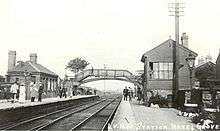Hazel Grove railway station
Hazel Grove railway station is a junction on both the Stockport to Buxton and Stockport to Sheffield lines, serving the village of Hazel Grove, Greater Manchester, England.
| Hazel Grove | |
|---|---|
 Hazel Grove railway Station | |
| Location | |
| Place | Hazel Grove |
| Local authority | Stockport |
| Grid reference | SJ919867 |
| Operations | |
| Station code | HAZ |
| Managed by | Northern Trains |
| Number of platforms | 2 |
| DfT category | D |
| Live arrivals/departures, station information and onward connections from National Rail Enquiries | |
| Annual rail passenger usage* | |
| 2014/15 | |
| 2015/16 | |
| 2016/17 | |
| 2017/18 | |
| 2018/19 | |
| – Interchange | 7,119 |
| Passenger Transport Executive | |
| PTE | Transport for Greater Manchester |
| History | |
| Key dates | Opened 1857 |
| National Rail – UK railway stations | |
| |
History
The station was built for the Stockport, Disley and Whaley Bridge Railway by the London and North Western Railway and opened on 9 June 1857. From 1923 until 1948, it was owned by the London Midland and Scottish Railway and, following nationalisation, it was operated by the London Midland Region of British Railways.
At one time there was another station in the village, Hazel Grove (Midland) station, on the Midland Railway's line from New Mills South Junction to Manchester Central via Cheadle Heath; this opened in 1902, but it was less conveniently situated and closed in 1917.
The line was extremely expensive to build with extensive earthworks. The navvies were accommodated in specially-built houses near the Rising Sun pub, which still exist, and are known as the "Navvy Mansions". The line from Edgeley Junction, just south of Stockport, to Hazel Grove was electrified in 1981 on the 25 kV AC overhead system. This allowed electric trains on the route from Altrincham, via Sale, to serve the station until that line was closed for conversion to Manchester Metrolink operation in late 1991; electric services to and from Piccadilly continued thereafter.
The signal box on the Buxton-bound platform remains in use. This controls the junction between the Buxton line and the chord linking it to the route through Disley Tunnel towards Sheffield at the country end of the station; it also controls a pair of carriage sidings at the Stockport end used for stabling trains that terminate here.

Facilities
The station is staffed all week, with its ticket office on platform 1 open 06:05-19:00 weekdays (until 20:00 on Fridays only), 07:00-20:00 Saturdays and 09:00-16:30 Sundays. There are waiting rooms on both platforms, toilets in the main building and a small coffee shop on platform 2. Train running details are provided via automated announcements, timetable posters and digital information screens. Step-free access is available to both platforms via the lifts built into the footbridge linking the platforms.[1]
Services
Today Hazel Grove is served by three trains per hour to/from Manchester Piccadilly – the two trains per hour to/from Manchester Piccadilly to Buxton and the hourly Manchester Piccadilly to Hazel Grove stopping service.[2] More trains operate in morning peak hours with East Midlands Railway running a service, the 8:17 service to Liverpool Lime Street. Only a few of the local DMU services between Manchester and Sheffield go via Hazel Grove – most travel via New Mills Central. Whilst between Hazel Grove and Buxton the line is not electrified, Hazel Grove through to Manchester Piccadilly is.
Class 323 units then operated the hourly Hazel Grove to Manchester Piccadilly service. From October 2015 until May 2018, diesel multiple units ran the service as it was extended to run to Preston and through to Blackpool North,[3] to replace the weekday service from Liverpool Lime Street that is now operated by EMUs.
Electric operation returned at the May 2018 timetable change, with one train per hour to/from Piccadilly worked by Class 319 EMUs. This was part of a major timetable revamp that will see 3 trains to Manchester each hour off-peak on weekdays and Saturdays and 2 each hour to Buxton. Regular running to destinations beyond Manchester ceased temporarily at the May 2018 timetable change.[4] Through running resumed in May 2019, with an hourly Monday-Saturday service running to Blackpool North now using Class 331 EMUs.
The single-track Hazel Grove Chord opened in 1986.[5] This allowed trains to/from Stockport and Manchester Piccadilly to access the former Manchester Central – New Mills South Junction line just south of Hazel Grove station and thus provides a faster route between Manchester and Sheffield than the former route via Romiley and New Mills Central. The chord also enables Sheffield trains to serve Stockport and run to/from Liverpool Lime Street.
References
- Hazel Grove station facilities National Rail Enquiries; Retrieved 23 February 2017
- Table 86 National Rail timetable, May 2018
- GB eNRT December 2017 Edition, Table 82
- "Rail North Committee Meeting – Item 5, Train Service Planning Update, p.2 Transport for the North Committee Meeting minutes, 9 October 2018; Retrieved 1 March 2019
- Hazel Grove Chord (looking south) Whatley, Peter, Geograph.org.uk; Retrieved 17 May 2017
- Radford, B., (1988) Midland Though The Peak Unicorn Books
- Harrison, P., (2006) Striking A Chord With Electric
External links
| Wikimedia Commons has media related to Hazel Grove railway station. |
- Train times and station information for Hazel Grove railway station from National Rail
- Railscot – Hazel Grove
| Preceding station | Following station | |||
|---|---|---|---|---|
| Northern Trains Hope Valley Line | ||||
| Northern Trains | ||||
| Terminus | Northern Trains Hazel Grove - Blackpool North Monday-Saturday only | |||
| East Midlands Railway Limited service |